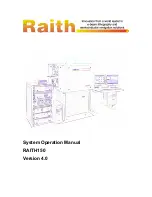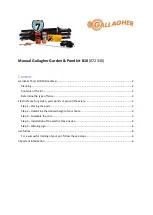
Operating Instructions—Type 324
12. Compute the signal amplitude. .02 VO LTS/DIV de
flection factor multiplied by the 10 X probe attenuation
factor and by the 2 1/2 divisions of deflection equal 0.5 V
signal amplitude. Note that this equal the difference be
tween the waveform's DC voltage limits found during DC
measurement in step 10, although the waveform's DC oper
ating level does not appear.
13. Set the VOLTS/DIV control to 0.1. Note that the
display amplitude reduces to 1/2 division. Again calculate
the input signal amplitude (0.5 V).
14. Pull the X5 VERT GAIN control out. Note that the
display amplitude increases to 2.5 divisions. Compute the
display amplitude by using the following procedure:
16. Calculate the square-wave frequency by determining
the reciprocal of the period. (Approximately 800 Hz).
17. Switch the TIM E /D IV control to 2 ms. Observe that
approximately 1 1 /2 square waves per division are now be
ing displayed. Calculate period (approximately 1.25 ms)
and frequency (approximately 800 Hz).
18. Using the Horizontal POSITION control, set the left
edge of the display to graticule center. Pull out the X5
HORIZ MAG. Observe that the start of the display remains
near graticule center, but that now the display is only one
square wave cycle per 3.2 divisions. Calculating the period
and frequency, you w ill find it to still be about 1.25 ms and
800 Hz respectively.
Divide the VO LTS/DIV setting by 5 to determine the
vertical deflection factor w ith the X5 VERT GAIN out.
M ultiply this deflection factor by the number of divi
sions of deflection and the 10X probe factor to determine
the input signal amplitude (0.5 V)
Operating the Horizontal Controls
15.
Calculate the square wave period. M ultiply the
number of divisions per one cycle of square wave by the
T IM E /D IV setting. Reset the horizontal POSITION knob as
necessary for convenient measurement. (Approximately
1.25 ms per cycle.) See Fig. 2-6.
1. Measure the number of divisions between identical points
on successive waveforms.
2. M ultiply by the selected T IM E /D IV value to determine
period time.
3. Solve for the reciprocal of period time to find frequency.
Fig. 2-6. Determining frequency.
19.
Slowly rotate the Horizontal POSITION control.
Note that any 20 per cent of the unmagnified display from
step 17 can be selected in this way for viewing as a magni
fied display.
20. Rotate the VAR IABLE (TIM E/DIV) slowly counter
clockwise. Note that the resultant decrease in sweep speed
causes more square wave cycles to appear in the display.
With VAR IA BLE fu lly ccw, approximately 8 square wave
cycles appear. Return the VAR IABLE control to CAL and
the X5 HORIZ MAG to in.
Operating the Trigger Controls
21. Note that the positive portion of the square wave is
being displayed at the beginning of the trace. Switch the
TRIGGER control to —AUTO and observe that the nega
tive portion of the square wave is being displayed at the
beginning of the trace. The + or — selection determines
whether the horizontal sweep is triggered by a positive
going (+) or a negative-going (—) signal. In the absence of a
signal, AUTO provides a free-running time base of relatively
constant brightness, regardless of the sweep rate.
22.
Push in the X5 VERT GAIN control and set the
VOLTS/DIV knob to .05. Connect the P6049 Probe to the
VERT INPUT connector. Then connect the probe tip and
ground lead across the output of a low-frequency sine wave
generator. Set the generator for a 2-V peak-to-peak, 60 Hz
output. Observe a sine wave which is 4 divisions peak-to-
peak. Note that the beginning of the waveform has a nega
tive (falling) slope. See Fig. 2-7(A ).
23.
Rotate the TRIGGER control slowly counterclock
wise from the —AUTO position. Note that as the control is
turned from the AUTO position, the trace disappears. As
the control is moved further counterclockwise, a point is
reached where the sweep is again triggered by the negative
2-12
















































